56 Ways to Promote Your Latest Blog Post After Publishing It

So, you've done your research. You've found good keywords, you've come up with a compelling topic. You've written a blog post, you've done the work in formatting it, and you've triple-checked it for errors. You've filled it with compelling images. You've scheduled it to be published, or you've done so already. Now what?
Now, three things need to happen.
- First, you need to get to work on your next post. Blogging is a Sisyphean task; it's a neverending work in progress. You will be pushing that boulder uphill for as long as you engage in online marketing. It gets more manageable, and you can outsource it, but it's a responsibility that never goes away.
- Second, you need to start watching your analytics. A single blog post might not have much impact, but you want to see how it performs nonetheless. More importantly, keeping an eye on your analytics will show you what effect number three has.
- Third, you need to promote your blog post. I've mentioned, offhandedly, that when you finish a blog post, you should "run it through your promotion engine," but what is that? Well, that's what today's post is all about. What is your promotion engine? What can you do after your blog is published to get it in front of more people?
I've come up with 56 different things you can do to promote a blog post. Some of them are low effort; some are high. Some of them will have disproportionate returns. Some might be entirely ineffective for your blog.
You won't know which is which until you do them and, critically, measure the results. I've also divided them up into categories to make them easier to discuss. You can treat this post like a checklist or a starting point to build your list. You can also feel free to suggest your favorite strategies in the comments since I know I've forgotten some.
Without further ado, let's dig in!
 30 Second Summary
30 Second Summary
You need to promote your blog post in multiple ways to get more readers and build links. First, share it across all your social media accounts like Facebook, Twitter, LinkedIn and Pinterest. You can also send it to your email subscribers and push notification followers. Look for ways to get influencers and other bloggers to share your content by reaching out when you mention or link to them. Think about turning your post into different formats like videos, podcasts or infographics to reach new audiences. Just avoid outdated tactics like trading links or mass forum posting.
General Promotion
First up, we'll start with your general promotion strategies. These don't require much additional effort, and these tips take advantage of other resources like an email list. Many of these are various marketing strategies that you should be using anyway. In all likelihood, you're using most or all of these, and that's perfectly fine; plow ahead to the other tips. These may not have high returns, but they're easy and a standard part of marketing.
1. Send Your Post to Your Email Subscribers. You want to be building an email newsletter at all times. Send your new blog post to them immediately, or include it in your regular newsletter digest.
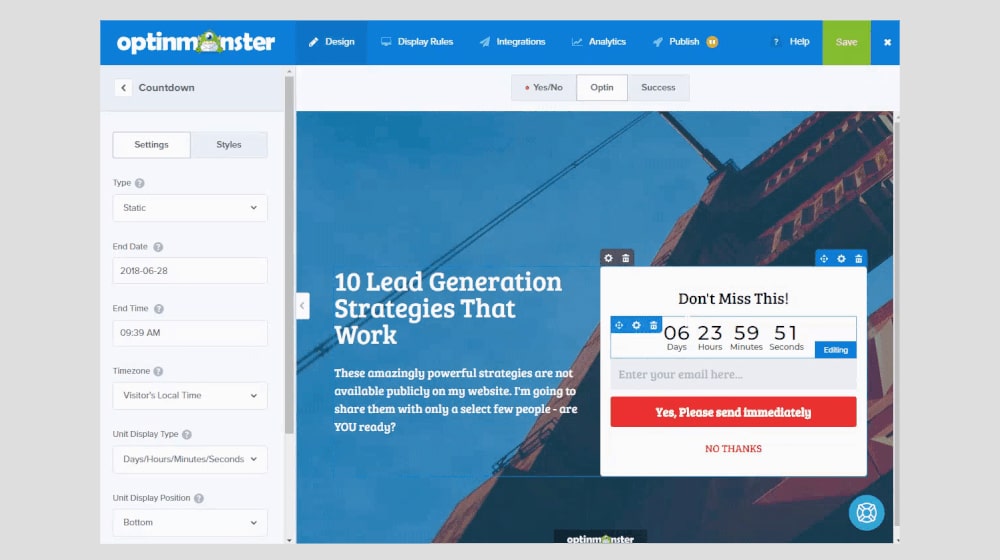
Here's a guide:
2. Send Your Post to Push Notification Subscribers. Consider using push notifications for mobile and desktop visitors. The ones who sign tend to be very engaged. It works like an email list but more immediate.

Here's a guide on how to do this:
3. Send Your Link to Anyone You Linked to or Mentioned. Blog posts do not stand alone; you have to reference other posts and content, either for citations or further reading on a subject. Whenever you mention someone else, make sure to add their name to a list of people to contact. Notify them that you liked their content enough to link to it in your new post.
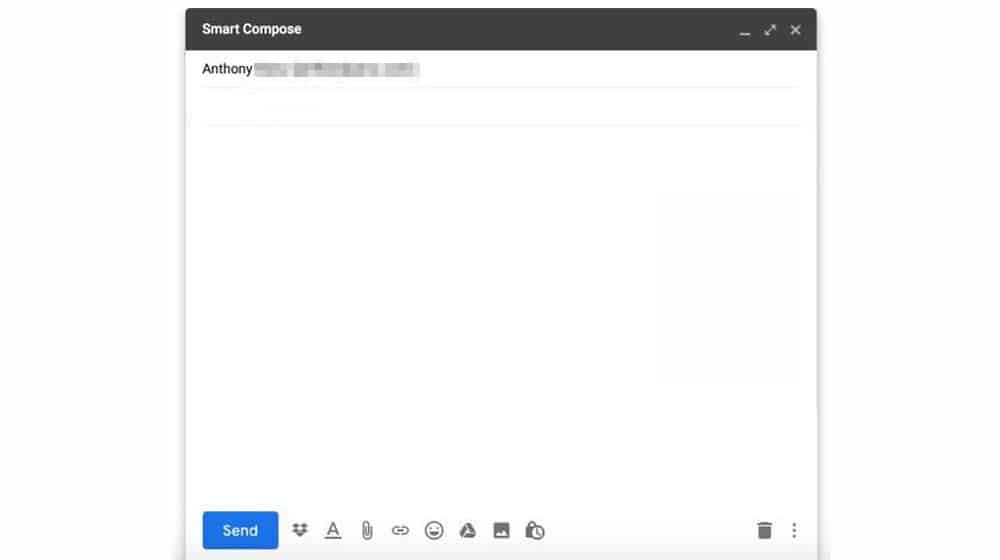
4. Add Internal Links to Past Posts. While not necessarily getting more traffic from external sources, adding your new post to your old posts as an internal link can help keep people around and engaged with your site.

Internal links are essential. Here's some further reading:
5. Submit Your Post to Industry Roundup Creators. Many people in your industry will be creators and curators of weekly and monthly roundups, focusing on niche content and specific subjects or formats. Identify those, and send your content to them for consideration.
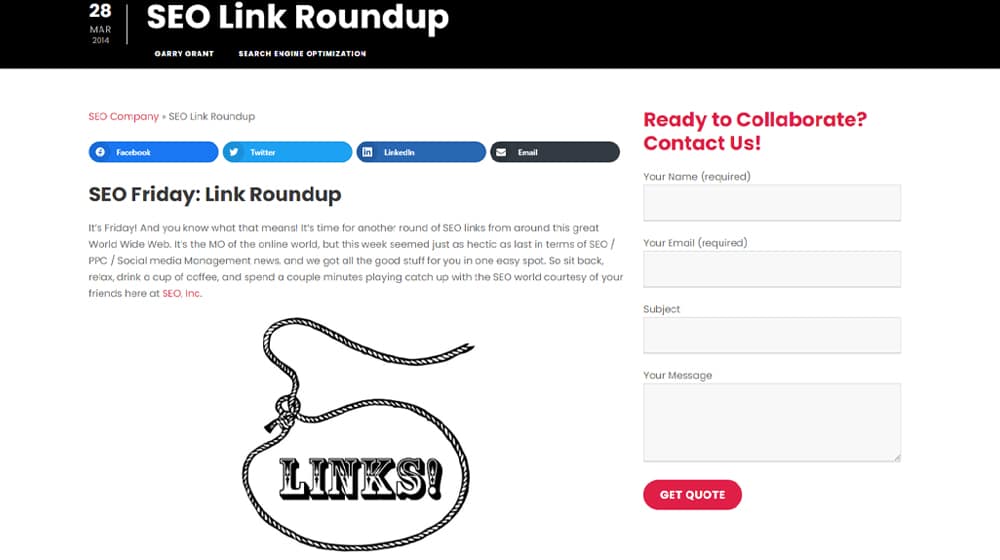
Here's a good guide from Respona on how to do this:
6. Join Mutual Promotion Communities. Various communities or "tribes" online form around niches and topics. Find tribes you can join, participate in sharing their content, and get yours shared in return. Triberr is one good option.
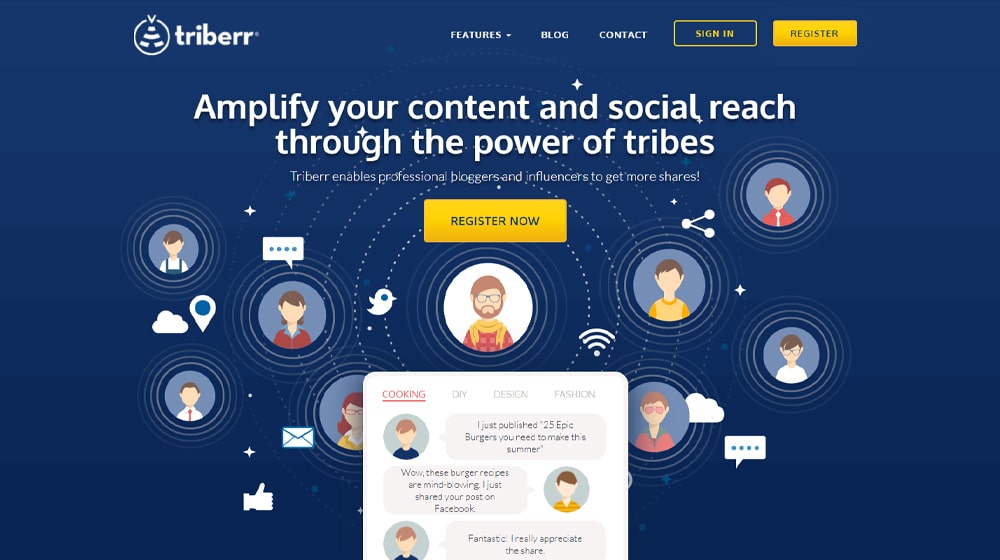
7. Submit Your Content to Blogging Directories. Article directories are very hit or miss, but the best industry directories can be good traffic sources and links. Don't submit to all of them. Instead, read through a list like this one and select a few of the best websites on the list. Many of the sites on these lists are lower quality, so you may have to do a little digging.
Social media is hugely variable and inconsistent with what does and doesn't go viral. However, nothing can go viral if it's not on the platforms in the first place. These are general strategies for taking advantage of the primary social networks you should use as a blogger.
8. Link to Your Post on Your Facebook Page. Facebook is the largest global social network, and while it has its share of issues, it's still growing year over year. So there's no reason not to use it, even if you don't want to pay for ads.
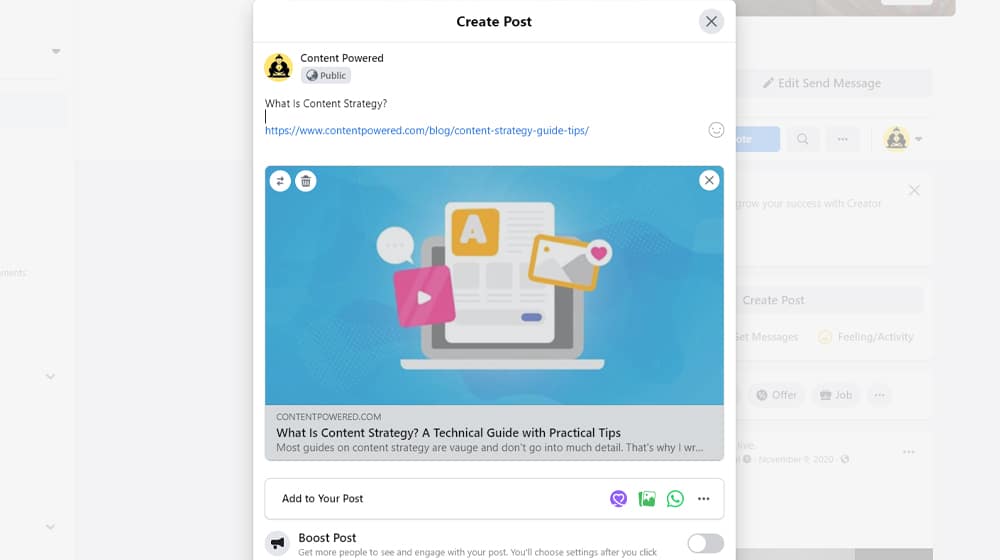
9. Link to Your Post on Your Twitter Account. Twitter is arguably the second-best social network in the world for marketing purposes. Of course, it, too, has many issues, but it's still an excellent channel for promoting your blog post and networking with other bloggers and fans.
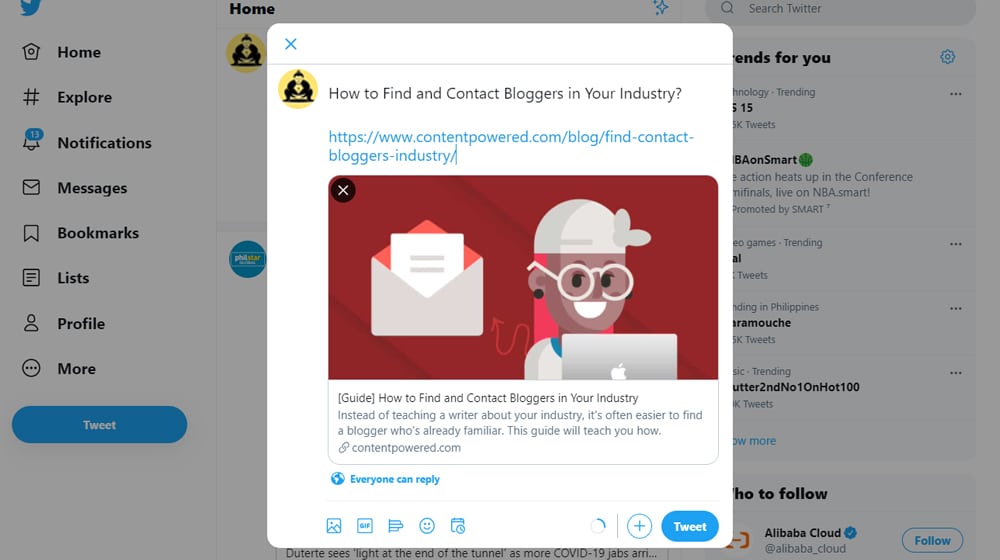
10. Link to Your Post on LinkedIn. LinkedIn is a great social network for professional development, and it's generally a good place to share your marketing content. Your audience will be smaller but more dedicated to your niche and your brand.
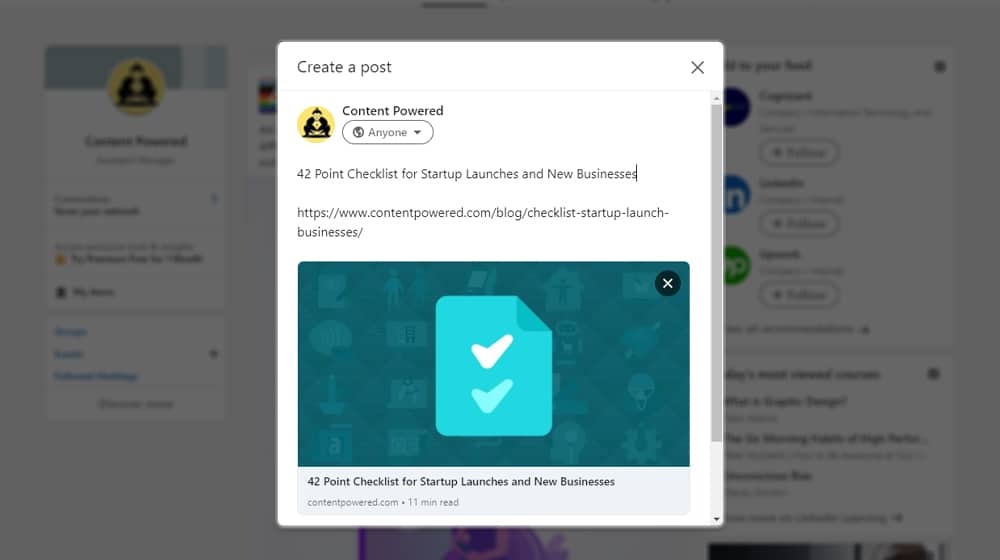
11. Link to Your Post on Pinterest. Pinterest has some issues with scraping content for pins, so beat them to the punch and submit it yourself. Pinterest also shows up everywhere, so you'll get a ton of Google search exposure, especially in image search.
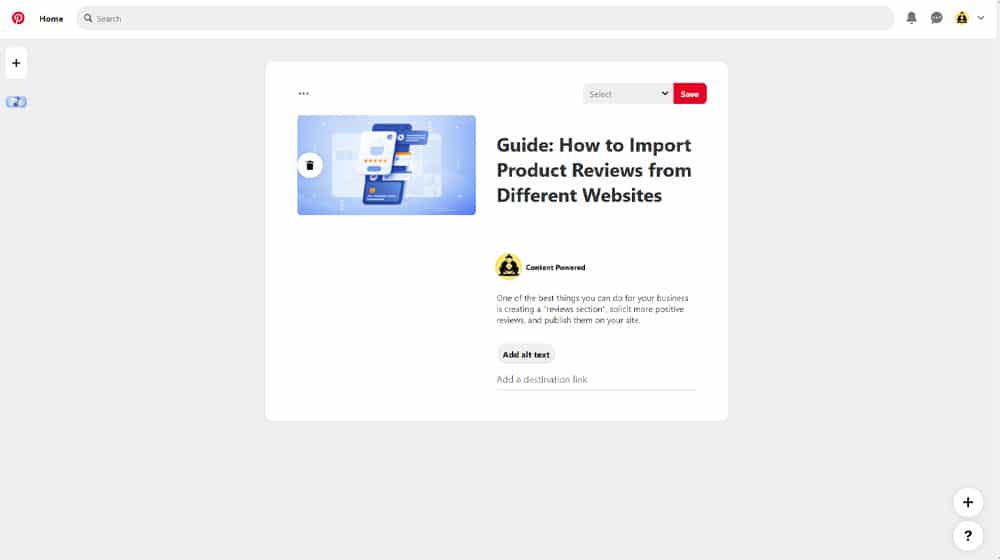
12. Link to Your Post on Instagram. Instagram requires an attractive image to promote your content, and you'll have to jump through hoops to add a link, but it's still an excellent way to engage with certain kinds of audiences.
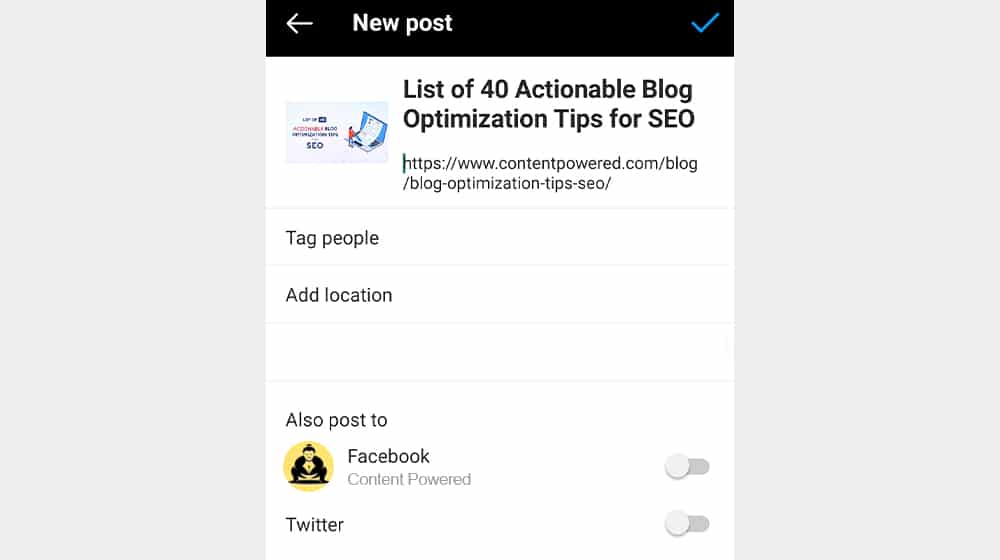
13. Link in Relevant Facebook Groups. Using Facebook groups for marketing is a time-tested technique. Join good groups, participate actively, and link to your content when a relevant opportunity arises.
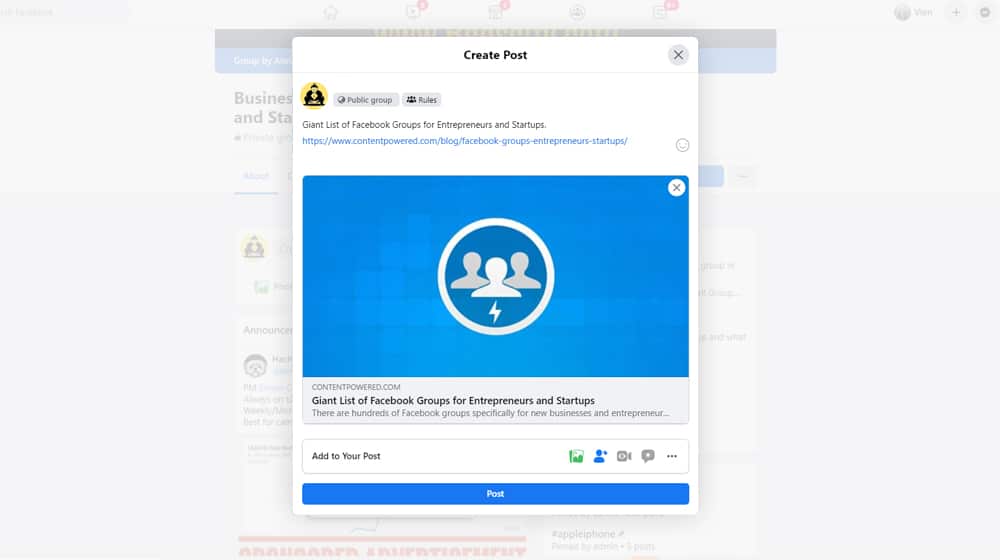
14. Participate in Relevant Twitter Chats. Twitter Chats are discussions centered around specific topics and hashtags. Follow these, participate in them, and link to your content in reply to people discussing your subject.
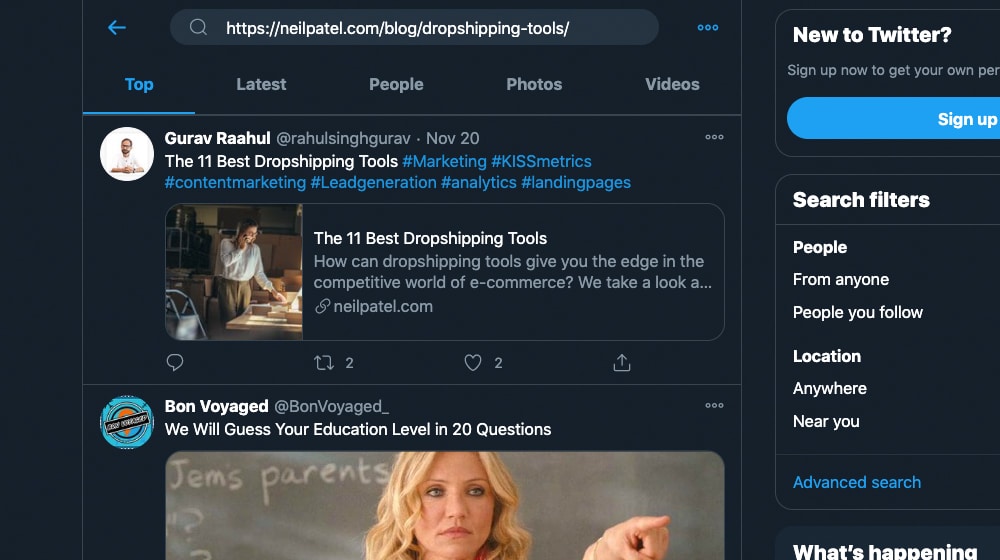
15. Link to Your Post in Relevant Subreddits. Reddit marketing is tricky because brands can and will get called out, have their posts deleted, or their accounts blocked if you don't do it right. If you do it right, though, you'll get a ton of traffic and engagement.

16. Identify and Submit to Niche Social Networks. There are a ton of tiny social networks out there dedicated to small niche communities. For example, Ravelry is for knitters, and GoodReads is for authors. Find and leverage these kinds of sites for promoting your content.
17. Repost Your Blog Post Several Times. Not a specific social network, but a general tip. Every social network (except maybe Reddit) benefits from posting your link multiple times over the first day, week, and month after publishing it. Each new link will reach new segments of your audience and bring in fresh returns.
General Link Building Strategies
Link build is generally not a short-term strategy, but every new link you get benefits your site as a whole. These strategies range from basic to advanced and can encompass a wide range of techniques and effort levels. Some are best used for your best content, while others are beneficial for your blog in general.
18. Look for Broken Links to Similar Content. When a page moves and it had links pointing at it, those links break. Broken links are bad for SEO and usability, so sites like to get rid of them. When you find one relevant to your content, send the site owner a message with your content as a replacement. Also, don't forget to look for other sites linking to the same page and approach them!
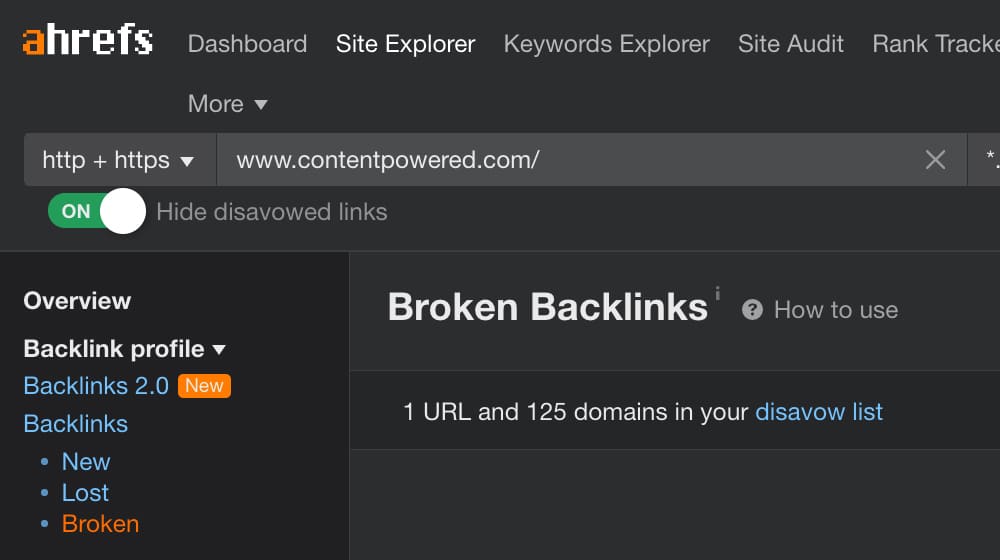
19. Create a Similar Topic Roundup Post. Bloggers throughout your niche create roundup posts to aggregate links to various kinds of content. You can do the same. Take your topic, write a new article that links to the flagship post, and find other relevant links to mention. People who notice the roundup will also find the link to your core content.
20. Convert Unlinked Mentions into Links. Use tools to find social mentions or mentions on blogs that don't link to you. Look, as well, for discussions of your topic that don't have links pointing to your post. Approach these webmasters or social users and ask if they can link to you instead or reply to them with your link.
21. Find Opportunities for Link Reclamation. Link reclamation is the process of finding links that you used to have that have since disappeared. Identifying those lost links, figuring out why they were lost, and getting them back is an entire process that is surprisingly effective. Occasionally, you'll find people linking to your new posts for a few days before removing them, and this can help you keep those links.
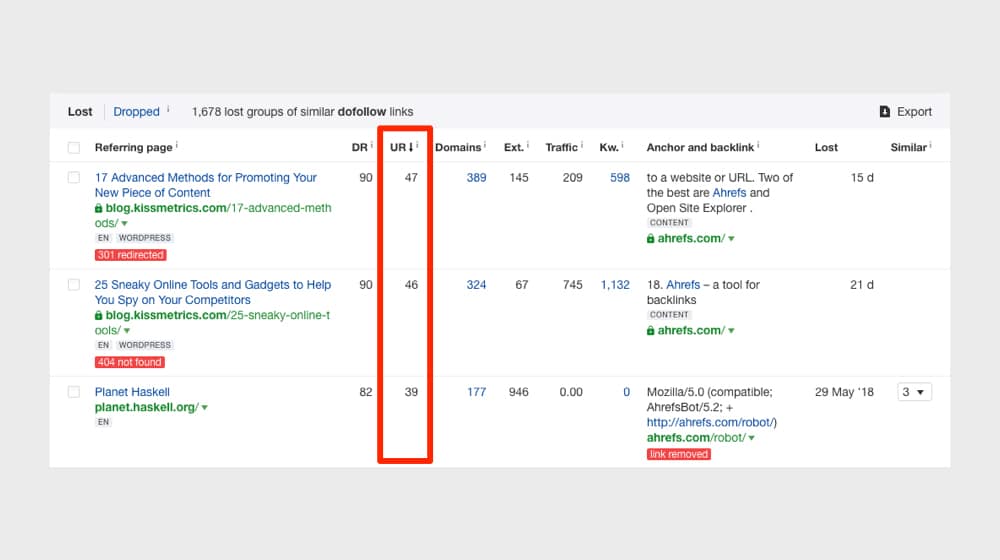
22. Steal Links from Inferior Content. You produce high-quality content (or at least I hope you do), so why not poach links from inferior content? Find worse content, find the people who link to or promote it, and pitch replacing those links with yours. This technique works very well if your content is more relevant and up-to-date, as it will improve the value of their content and bring it back up to date.
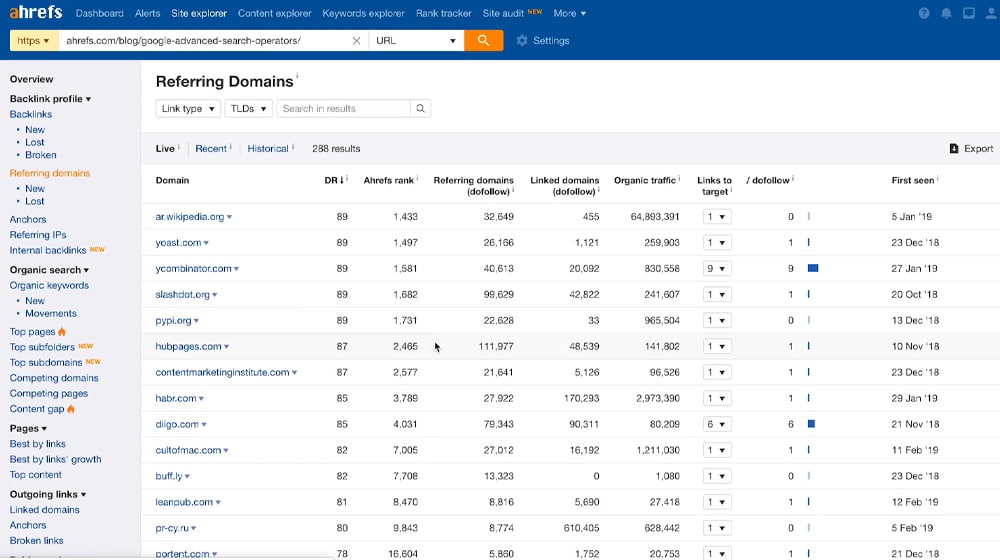
23. Answer Relevant Questions on Quora. Quora is the new Yahoo Answers, full of low-quality asks, but many good discussions are also going on. Find people asking questions about your topic and leave your link in response. Just don't astroturf the questions if you want to stay ethical.
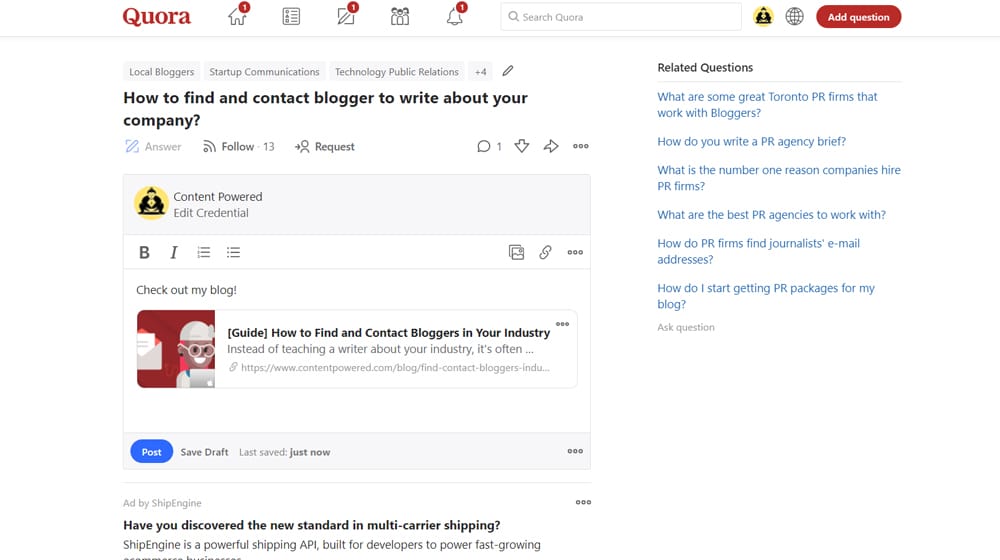
24. Answer Relevant Questions on StackExchange. You can apply the above advice on Quora to StackExchange as well. I've seen a handful of businesses advertise successfully without being too pushy.
Influencer Networking
Influencers are people who have followings, communities, reputations, or other influence over your industry or niche. Identifying them and leveraging them to promote your content is a viable strategy, but you must do it carefully to avoid alienating them or building a bad reputation for yourself.
25. Find Related Posts and Link in the Comments. Blog comment marketing is one of the oldest strategies in the books, and while a lot of it is spam, careful use can still leave you with decent links and exposure. Just make sure to do it right.
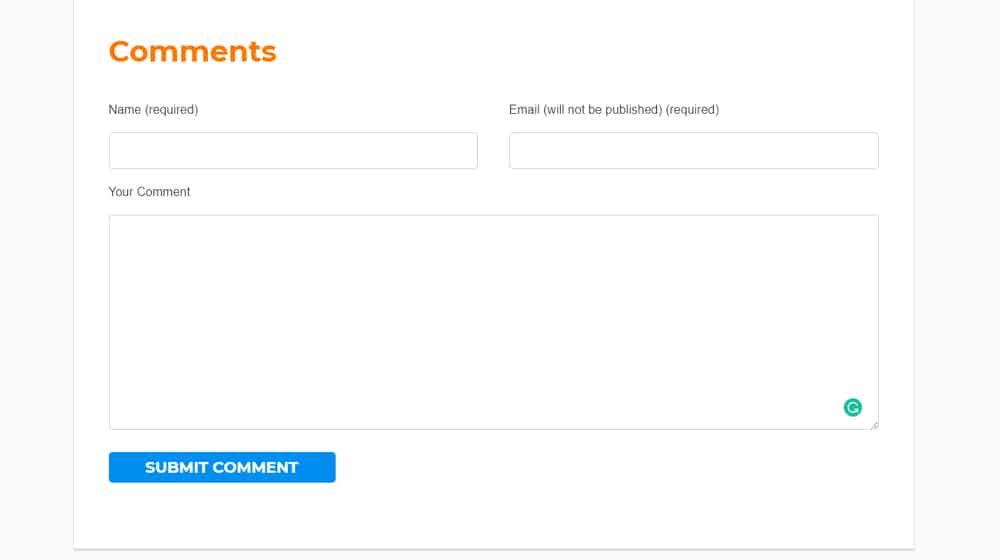
26. Send Your Link to Relevant Influencer Bloggers. Of course, there are always bloggers who dominate their industries. However, they are often looking for new fresh content, ideas, and people to promote and network with. Make yourself one of those people by identifying these influencers and networking with them yourself.
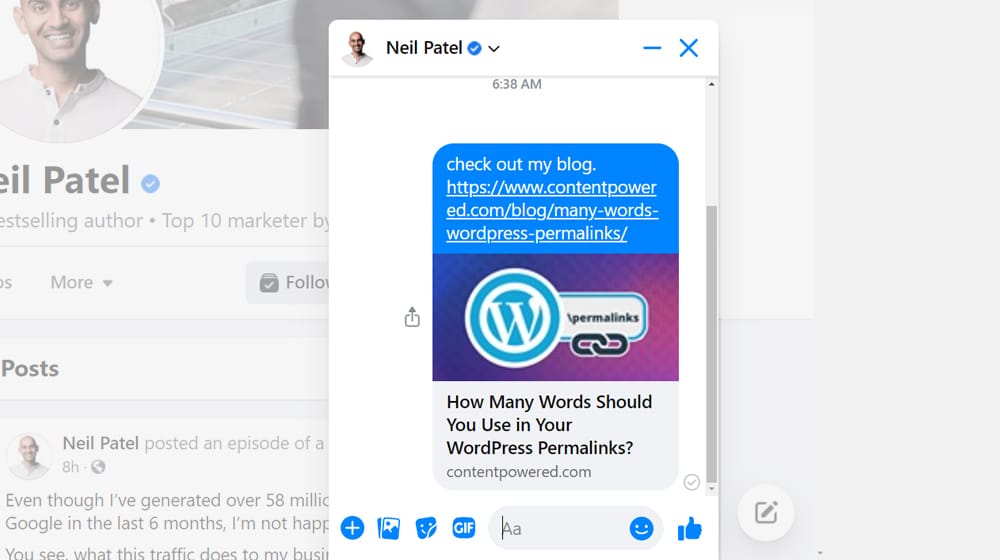
27. Send Your Link to Relevant Social Influencers. The same goes for social media influencers. And no, the two lists aren't always the same. There are probably influencers in your niche you've never heard of because they only operate on social media, and you haven't seen their posts. Identify those people and work with them.
Content Repurposing
Blog posts are powerful pieces of content, but they don't have to remain blog posts. You can leverage the work you put into researching and studying your topic to create multiple alternate formats for your content, which you can then promote individually. Don't forget that you can share the content you develop here in other ways already listed in this post!
28. Convert Your Post to a Script and Record an Audio Version. An audio version or a "podcast" version of your blog posts allows you to reach a whole new audience through podcast networks, as well as to offer an accessible option for those browsing your site with reduced vision. Here's my guide on how.
You can also submit your podcast to podcast directories after you're finished recording, and there are a lot of those out there.
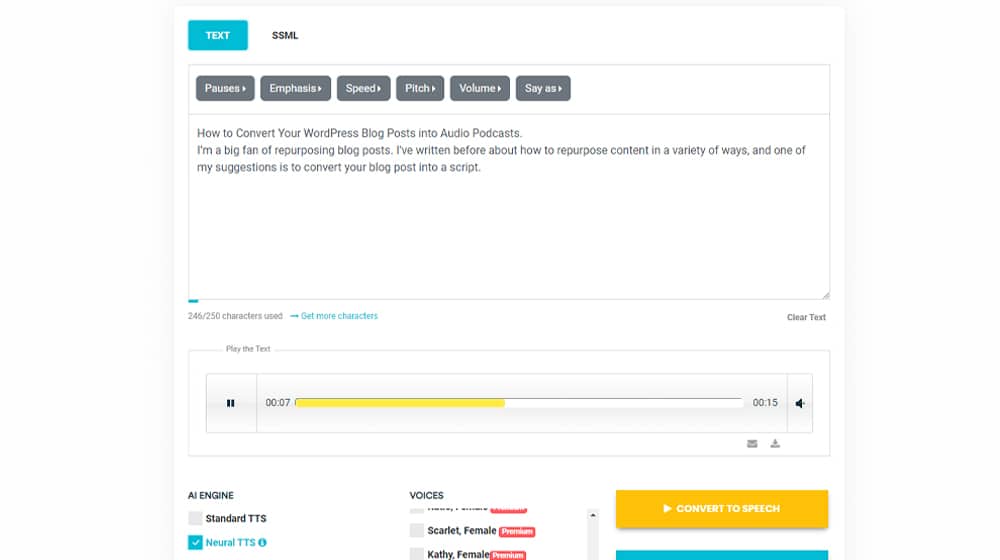
29. Set Your Audio Script to Video and Post to YouTube. The hardest part of a video is the audio, but you're already good to go if you've done that with the podcast method. Just set it to animation or a simple video, and you're already ready to upload it to YouTube. In addition to YouTube, consider DailyMotion, Vimeo, or other video sites.

30. Pare Down Your Script and Create an Infographic. You can use stills from your video or go all-out with custom graphic design. Infographics are potent sources of traffic if you market them correctly.

31. Send Your Infographic to Infographic Directories. Here's my list of infographic directories. I've used them with infographics in the past and had some pretty tremendous results, and I bet you can do the same with yours. They help get the ball rolling, which is the hardest part of infographic promotion.
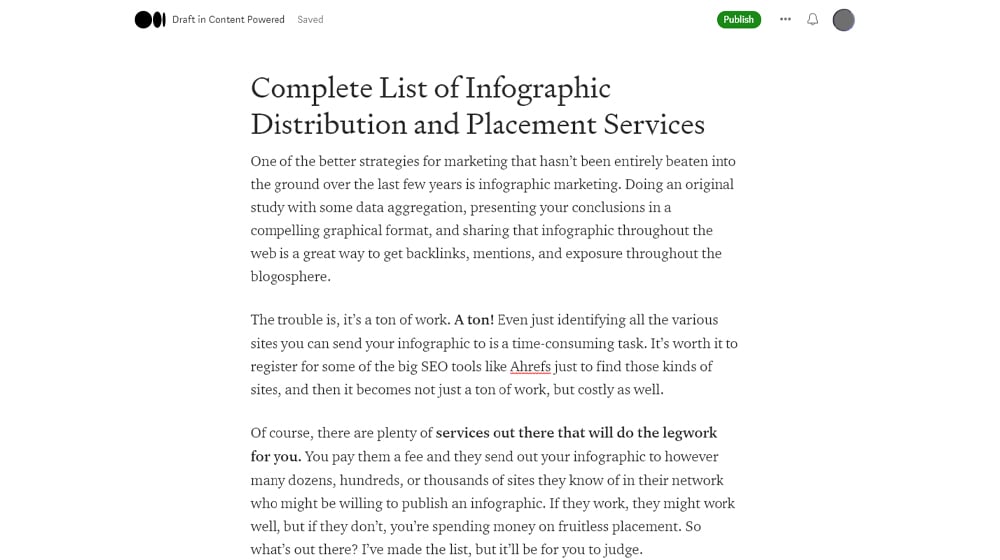
32. Send Your Infographic to Relevant Bloggers. Identify specific bloggers who share and embed infographics and write a custom article to go along with it. It's like guest posting on steroids.
33. Cut Up Your Infographic and Create a Slide Deck. A slide deck is just a PowerPoint slideshow, combining images and text with an accompanying presentation. You have everything you need to make one of these in minutes between a video and an infographic.
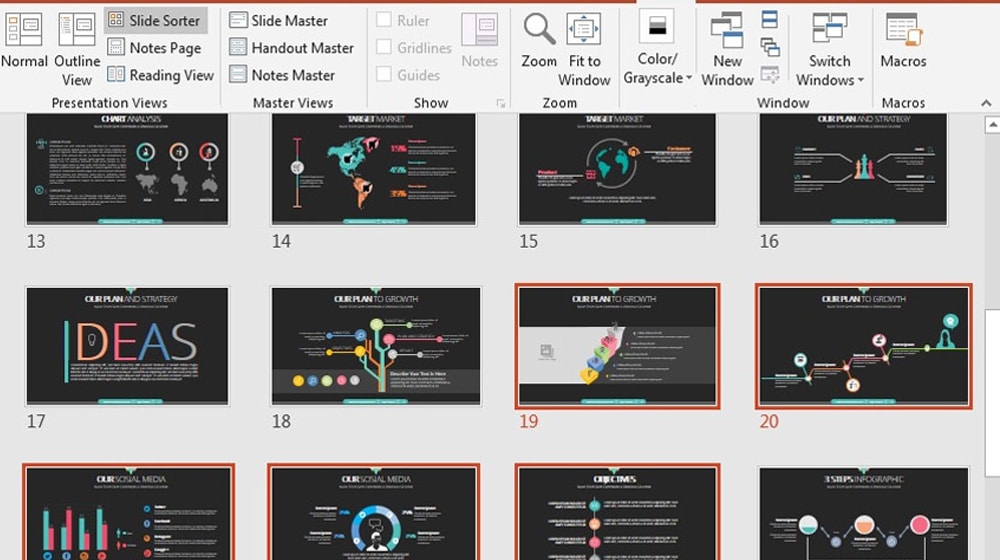
34. Repackage Your Content as a Longer eBook. Marketing using eBooks is just blog post marketing with an extra CTA (call to action). It's reasonably easy to buff up your blog post into a more comprehensive and valuable book and market that on its own. You can even add these in the middle of your blog post to increase engagement; I wrote a tutorial about this here.
Not every blog wants to syndicate its content, but if this is something that appeals to you, this can be a great way to gain more exposure to an audience you otherwise wouldn't be able to access. Just make sure to do it properly to avoid the risk of duplicate content issues.
35. Post Your Blog Post on Medium.com. Medium isn't quite as good as it used to be, and a few recent changes have started to kill off their reader base, but they're still perfect for syndication with zero other effort involved. Please don't use it to host your blog, but syndication is fine.
36. Post Your Blog Post on LinkedIn Blogs. LinkedIn blogs are an excellent place to syndicate posts to get exposure to an audience your typical blog doesn't reach. Even if you post links on LinkedIn, syndicating content reaches a different audience.
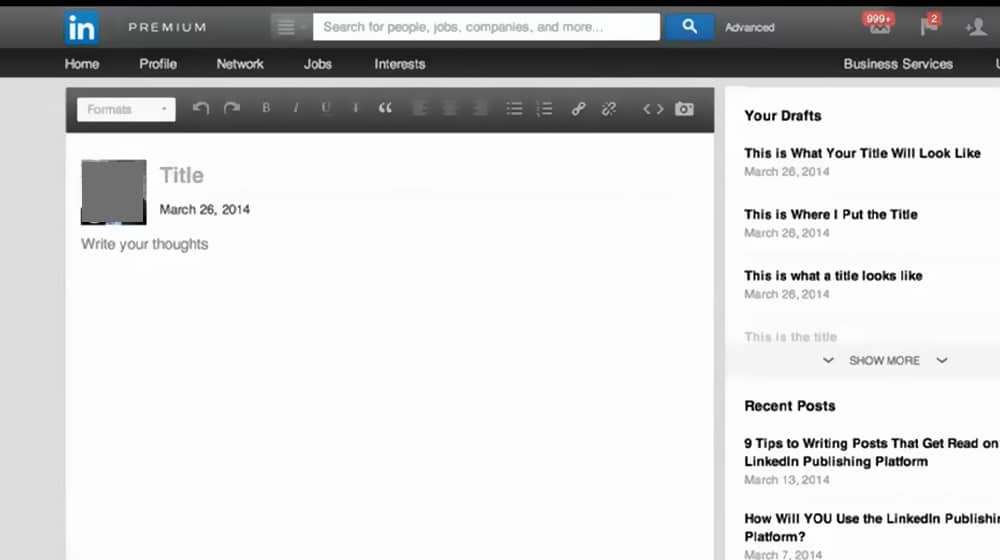
37. Post Your Blog Post as a Facebook Instant Article. Not everyone has access to Instant Articles, but using Facebook's platform to syndicate your content can get you an advantage with native content and users on the site itself.
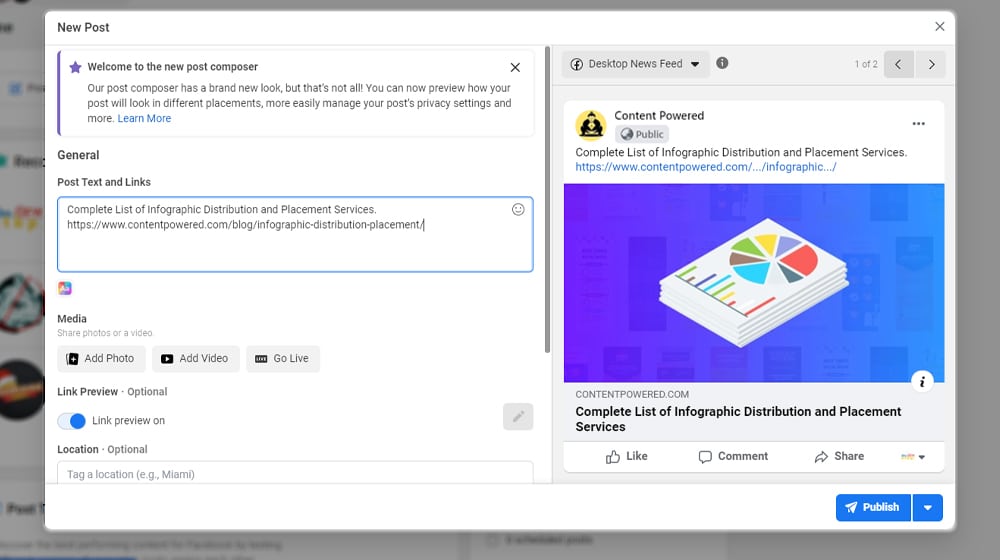
38. Submit Your Post to Content Syndication Sites. Of course, there are a ton of different blog aggregators and content syndication networks out there. Just be careful not to enroll in the spammier sites, and make sure to do your canonicalization.
Second-Stage Promotion
Second-stage promotion does not directly promote your blog post but can use your blog post as part of its promotion. For example, you can develop a webinar for your business on your topic. As part of the webinar, you can link to your blog post as an example discussion on a topic you discuss. Alternatively, you could use it to assign "homework" for your audience or as further reading on a topic that you touch on later.
39. Create a Topic-Focused Webinar. As mentioned, a webinar can be an excellent way to promote yourself as an authority on a topic and promote your content as an additional source of value.
40. Create a Niche Instagram Story. Instagram Stories are short, temporary videos that can work well to drum up interest and traffic from an audience during a promotion spree.
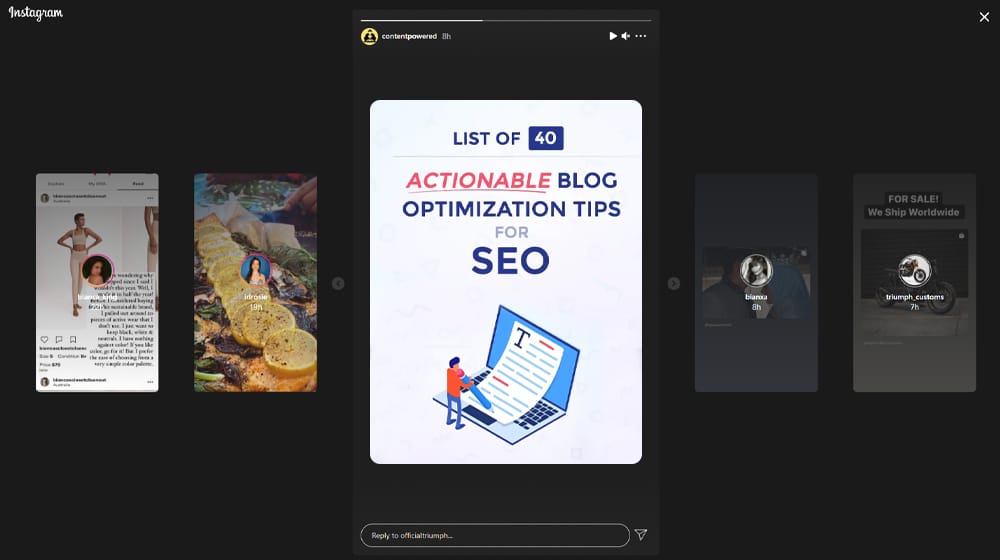
41. Create a Niche Facebook Story. Facebook Stories are just Instagram Stories with a slight twist for the Facebook audience.
42. Create a Livestream on Facebook, YouTube, or Twitch. Livestreams can work for certain kinds of marketing. I wouldn't recommend doing one for every blog post you publish, but if you host topic-focused live streams regularly, you can always have a relevant blog post ready to go.

43. Offer to Guest Post on Similar Topics for Other Blogs. Guest posting is always going to be a good strategy. It looks different from how it used to, but it's still a great option, even today.
44. Add Your New Link to Your Email Signature. People underestimate how often they communicate via email. Adding a new link to your signature is an easy way to get people you talk to reading your content.
45. Sponsor or Participate in Industry Events. Again, this isn't a way to promote your blog posts, but it does boost your brand, and anyone searching for your brand will find your recent content.
Paid Promotion
While you can do most of the above with little or no investment, these last few strategies directly convert money into traffic. There are many good reasons to invest in paid ads, but you need to make sure the content you're promoting is worthwhile as a landing page.
46. Create and Run Facebook Ads. Facebook ads are some of the cheapest and most well-targeted ads out there, though you have a ton of competition these days. Nevertheless, careful targeting can still get you a lot of results.
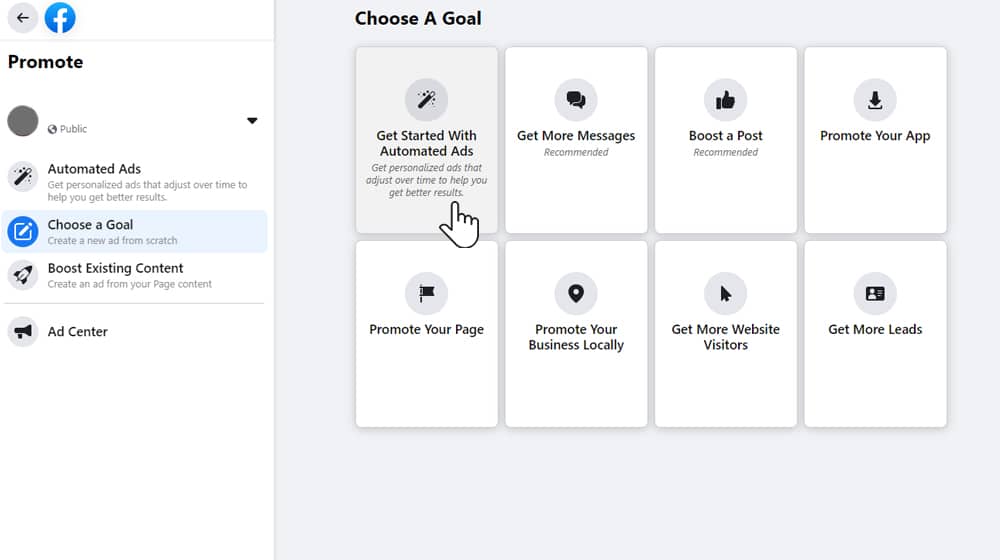
47. Create and Run Twitter Ads. Promoted tweets are always a good option to convert some money into an initial burst of traffic.
48. Create and Run Reddit Ads. Reddit, for all their talk about hating advertising, also allows you to pay for ads. So consider doing both organic and paid promotion at the same time in different communities.
49. Create and Run Google Ads. Google Ads will always be one of the most straightforward ad network choices, so they're an excellent choice to consider if you have limited advertising money.
50. Create and Run General PPC Ads. There are dozens if not hundreds of PPC networks out there to investigate, many with their unique publisher networks. Find ones that work best for you.
Miscellaneous
As we near the end of this article, here are a few final yet potent strategies that might have slipped under your radar:
51. Content Teasers on Social Media. Before publishing your next piece of content, tease snippets or highlights across your social media platforms to build anticipation among your target audience. My favorite strategy is to post 1/3rd of the content and include a link to the rest at the bottom, like on Medium or LinkedIn articles. This gets them hooked and improves the chances they'll click through to read the rest on your website.
52. Partner With Other Bloggers. Consider forging partnerships with other bloggers. By creating a piece of content together, both parties can promote the content to their respective audiences, giving access to a wider audience for both. Sites like BlogEngage or Triberr are communities where bloggers share and promote each other's content. You should take care on these networks and be selective, though; they can host a lot of spam, so you should pick only the highest quality bloggers to network with.
53. Tweetable Quotes. Embed tweetable quotes within your content. It encourages readers to share insightful snippets, increasing exposure on platforms like Twitter. You can use a "click-to-tweet" plugin on your WordPress posts pretty easily with a plugin, too.
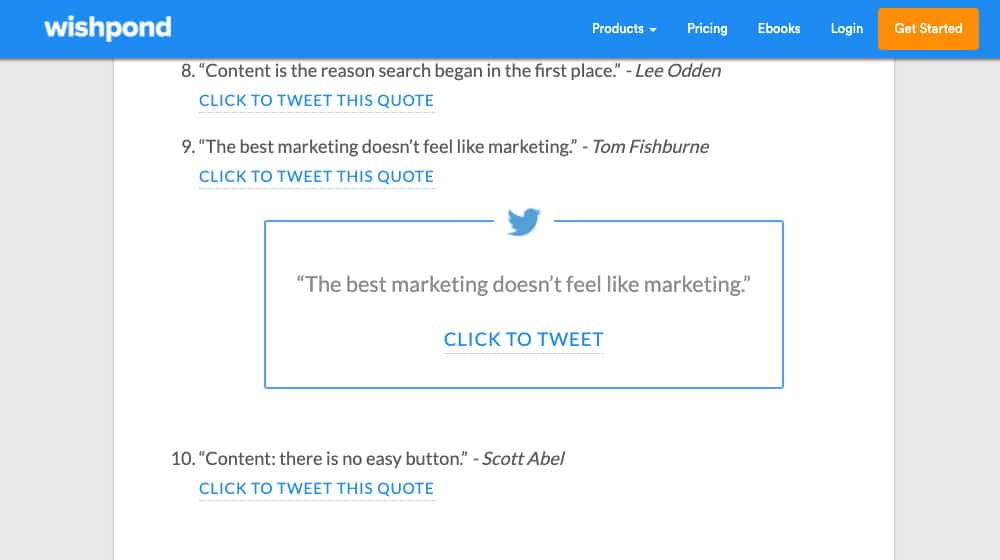
54. Answer Questions. Platforms like Quora or Stack Exchange allow for content promotion by answering relevant questions and linking back to your blog for a detailed answer. This is also known in some circles as "parasitic seo".
55. Content Roundups. Participate or initiate weekly or monthly blog roundups where you and other bloggers share the best content from each other's sites. I get mentioned in these roundups on other sites all the time, and it's always appreciated, especially when they drive visitors to my site! I wrote a post about round-ups here, if you want to read about them in greater detail.
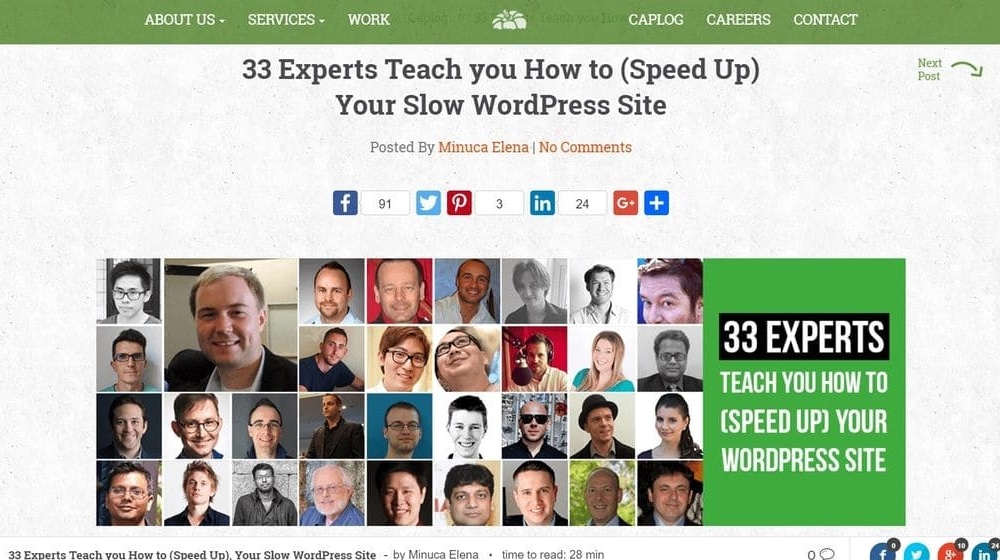
56. Utilize Share Buttons Strategically. Ensure that you have social share buttons readily available on your blog content. They should be strategically placed (top, bottom, or floating on the side) so that readers can easily share your content on their preferred social media platforms. The ease of use is crucial for maximizing social shares.
Old / Not Recommended Tips
These tips are recommended on a bunch of other guides out there, but these search engine optimization techniques are super outdated and may even be against Google's Search Essentials.
Make sure to avoid these in 2023/2024 and beyond:
Backlink Exchanges: Previously, many websites exchanged backlinks to improve search engine rankings. However, Google's Penguin algorithm update has penalized unnatural backlinking practices. Exchanging links indiscriminately can now harm your site's ranking and can be seen as manipulative.
Blog Directories: While they were once a popular way to gain visibility and backlinks, many blog directories are now considered low-quality in the eyes of search engines. Adding your blog to low-quality directories can now hurt your reputation and search rankings.
Promote on Bookmarking Platforms: Social bookmarketing sites were once popular to get free backlinks. However, many of these platforms aren't as popular or influential anymore, and most of them are penalized on Google for their linking practices. Furthermore, Google's algorithm changes have made it clear that low-quality bookmarking sites can harm your SEO. I'm not sure why so many people still recommend these sites, but it's best to just avoid them. You can read John Mueller's stance (Google's Search Relations Team lead) on this in greater detail here.
Email Outreach: While it can be a powerful tool if done correctly, cold email outreach is often seen as spam by recipients. Poorly executed outreach campaigns can lead to your email being blacklisted, low open rates, and a tarnished brand image. Today's email platforms and users are more sophisticated, and they prioritize genuine, valuable interactions over unsolicited mail. You don't like receiving these spam emails, do you? Neither do they.
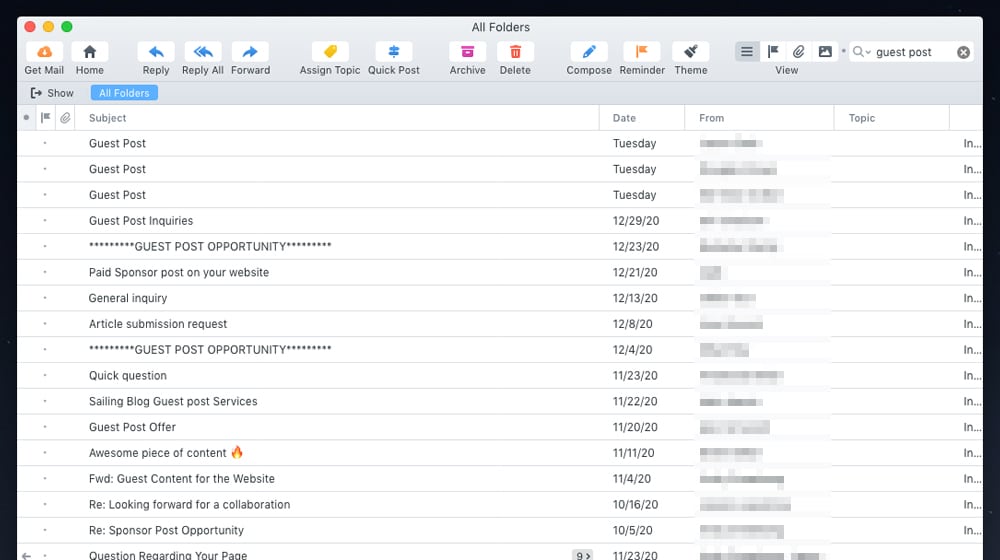
Forum Posting: In the past, forum posting was a common method to build backlinks and drive traffic. However, indiscriminate posting or sharing links in forums without genuine engagement is now seen as spammy behavior. Many forums also use "nofollow" tags, rendering such links useless for SEO purposes. Additionally, search engines may penalize your site if they see a pattern of low-quality forum backlinks.
So, there you have it; a massive list of over 50 strategies you can use to promote your blog posts. Some are simple and easy; others are complex and time-consuming. Of course, you don't have to do all of them for every post you create, but it's a good idea to familiarize yourself with every blog promotion strategy so you can put them into use where appropriate.
Do you have a favorite technique that I haven't listed? Please, feel free to discuss it in the comments. Just don't recommend the shady stuff like buying links, using a PBN, or buying email lists. I try to keep my recommendations wearing a white hat and prefer not to recommend strategies with a good chance of backfiring.



 30 Second Summary
30 Second Summary



February 08, 2022
Very good thank you sir for this guide
February 10, 2022
Hey Rashdan! Happy to help out 🙂 keep on blogging!